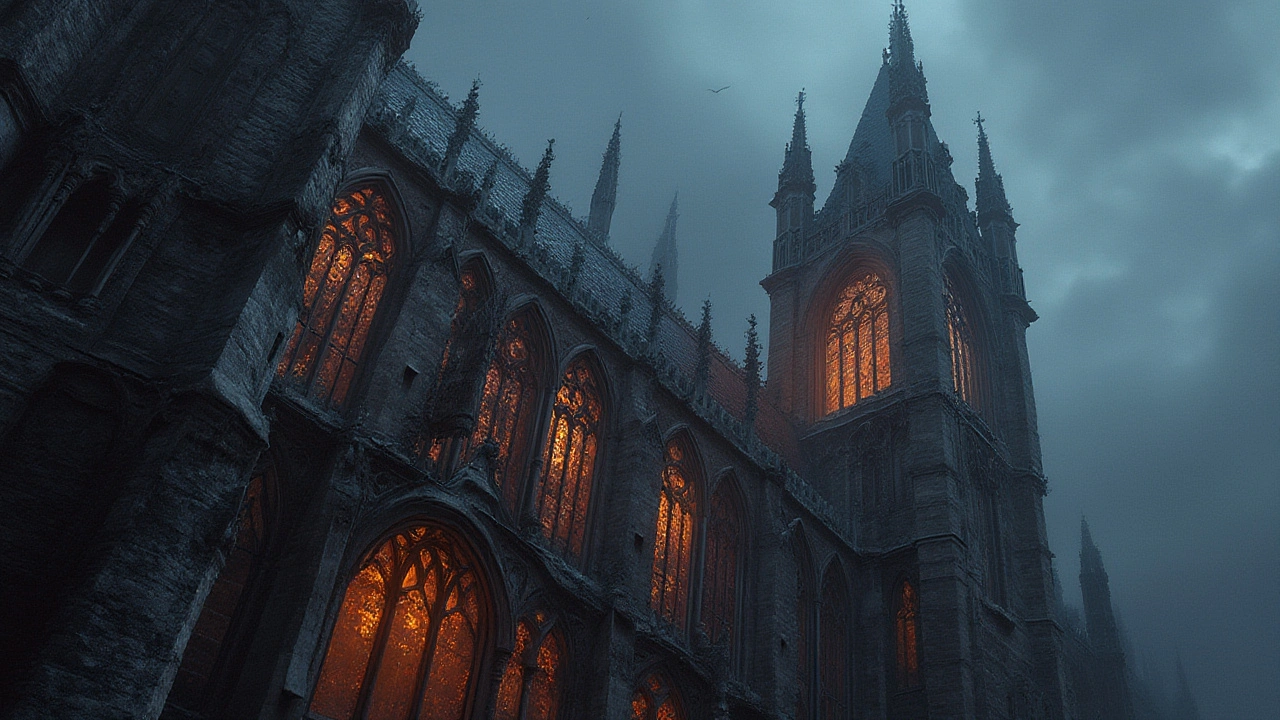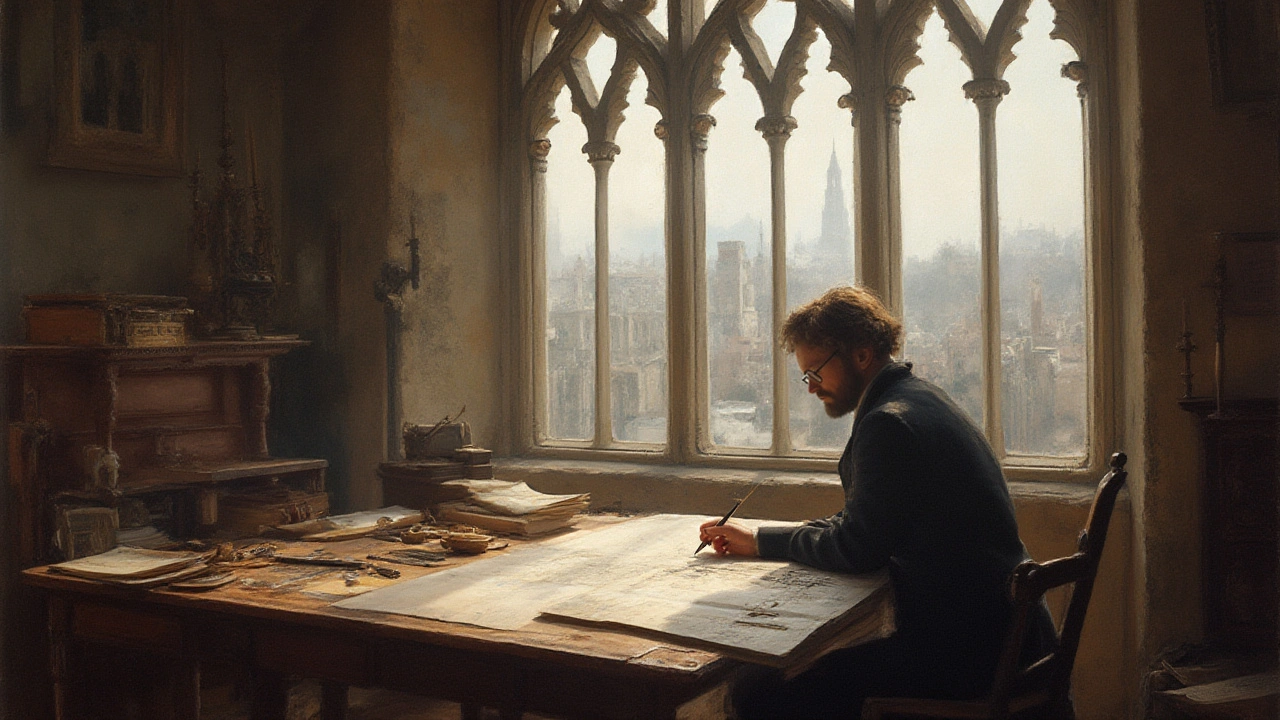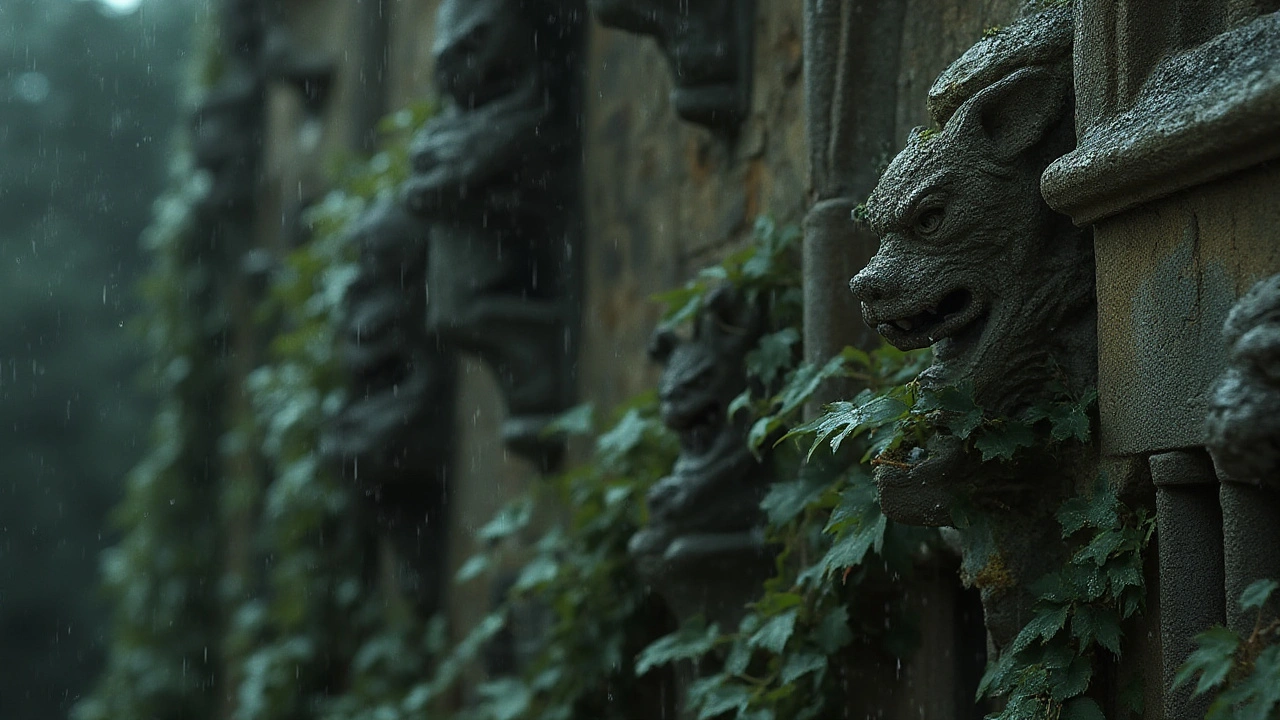Gothic Revival Architecture: Imagination and Innovation in Every Spire
 Jul, 19 2025
Jul, 19 2025
Gothic Revival architecture doesn’t just whisper its secrets—it shouts them from spires, bell towers, and wild, looping arches. You can walk past a building from the 1800s and almost expect thunder to roll or a heroine in a windswept dress to glide by. Unlike its medieval ancestors, Gothic Revival was born out of Victorian obsessions, industrial advances, and an almost feverish hunger to reimagine the past. It’s not just a style, but an attitude—one that refuses to blend in quietly with the crowd. What other revival movement has inspired everything from churches to university campuses to punk album covers? And those stained-glass windows? Little explosions of color that make you stop, look, and maybe even daydream a bit. Let’s pull open the heavy oak door, step inside, and see what makes Gothic Revival one of the boldest forms of creativity in architecture's long story.
What Defines Gothic Revival Architecture?
You might think every building with a pointy arch is Gothic, but not all are cut from the same block of stone. Gothic Revival isn’t medieval; it’s a 19th-century remix. You’ll spot it fast if you know what to look for. Clusters of tall, narrow windows with pointed arches—they’re everywhere, usually decked out in stained glass. Look up and you’ll catch those steeply pitched roofs that collect snow faster than any flat-roofed cousin. Patterned brickwork, finely carved woodwork, and rows of ornate finials make even modest homes seem dramatic. Some houses look like they could double as movie sets for Dracula or Harry Potter.
Ever noticed those wild gargoyles perched on rooftops? They weren’t just for decoration; they were practical too, often serving as water spouts to keep rain off the walls. Have you walked through a door with a trefoil or quatrefoil (that’s three- or four-lobed) window above? That’s pure Gothic Revival magic, echoing cathedral style without the cathedral budget. Don’t forget the tracery, those stone lace patterns in windows, which look like someone spent hours carving swirls just to filter the sunlight.
Now, here’s a cool fact: some Gothic Revival architects got so into medieval accuracy, they invented entire fake histories for their buildings, complete with invented crusader relics or secret passageways. It’s creativity cranked up to eleven. The British Houses of Parliament, the St. Pancras railway station in London, and New York’s St. Patrick’s Cathedral? All shimmer with Gothic Revival energy. Even in small towns across the US and Europe, churches, universities, and even houses grabbed hold of this style for a hint of grandeur.
Yes, Gothic Revival had rivals—the soberer Greek Revival or the breezier Italianate styles. But nothing could touch its sheer drama. The proliferation of cast-iron technology and improved stone-cutting tools meant homeowners didn’t have to be kings to get a little Gothic glam in the suburbs. The reach was ambitious, from Carnegie libraries to rural chapels. While some critics at the time called it overwrought or silly, anyone with a taste for fantasy or epic tales knows exactly why these buildings thrill us.
A Brief Timeline of the Gothic Comeback
While true Gothic ruled back in the Middle Ages, the revival waited for the 18th and especially the 19th century to break through. Picture England in the late 1700s: candles flickering, people reading tales of haunted castles, and writers like Horace Walpole building Strawberry Hill House—a wild mashup of turrets, battlements, and stained glass. This place practically invented the English “Gothic novel.” Suddenly, the gothic look was “in.”
By the 1830s and 1840s, the movement exploded. Augustus Pugin, one of the masterminds of the style, believed that Gothic was the only honest and moral architecture. He published books packed with ideal Gothic home plans. In America, architects like Richard Upjohn and James Renwick Jr. ran with the idea. Upjohn’s Trinity Church in New York delivered a solid punch of Gothic energy to the city’s skyline in 1846. Meanwhile, Renwick’s Grace Church and, later, the Smithsonian Castle brought pointy arches and carvings to Washington D.C.
Universities loved the style. Yale, Princeton, and Oxford all jumped onto the Gothic Revival bandwagon, giving campuses a sense of weight and scholarly tradition. Even the Ivy League got Gothic cred. Some cities, especially London, saw whole neighborhoods influenced—check out the grand terraces around Highgate. Neighborhood churches across Canada, Australia, and New Zealand copied the style. The popularity lasted well into the early 20th century. When Art Deco started making waves in the 1920s and 1930s, Gothic Revival faded, but you’ll still see echoes in fantasy movies, architectural cosplay, and pop culture.
Here’s a little snapshot of major moments:
| Year | Event or Building | Location |
|---|---|---|
| 1749 | Strawberry Hill House begins construction | Twickenham, England |
| 1836 | Houses of Parliament design competition | London, UK |
| 1846 | Trinity Church opens | New York City, USA |
| 1873 | St. Pancras railway station opens | London, UK |
| 1879 | University of Glasgow, Gilbert Scott Building completed | Glasgow, Scotland |
| 1878 | Smithsonian Castle completed | Washington, D.C., USA |
The timeline shows just how widespread and enduring the style’s appeal was. It wasn’t just a passing fad or a single-city hit; it was global.

Why Was Gothic Revival Seen as the Pinnacle of Creativity?
One word: drama. Gothic Revival wasn’t satisfied with safe, boring shapes—it wanted to dazzle, stir the soul, and push every creative button. At the time, most domestic and public architecture stuck with simple, classical shapes and modest ornament. Gothic Revival shouted, “Let’s do something wild!”
The movement opened up a playground for architects where pretty much anything went, as long as it was pointed, colorful, or ornate. Stained glass, previously reserved for grand cathedrals, found its way into parlors and libraries. Architects and craftsmen collaborated on intricate carvings of leaves, animals, and mythological creatures, each adding personal flourishes. You’d sometimes find whole walls decorated with folk motifs, medieval stories, or secret symbols—all meant to catch the eye and imagination.
The creativity extended to technology, too. The new ability to mass-produce iron and detailed stone pieces let the style flourish in homes that would have been far too costly a century before. Fancy a spire on your row house? No problem—just order it from a catalog. Pattern books, like those published by Pugin or Andrew Jackson Downing, spread Gothic Revival ideas across continents. Suddenly, anyone could bring a dose of old-world fantasy to the suburbs or countryside.
Some of the most awe-inspiring libraries, like Canada’s Parliament Library or the Beinecke Rare Book Library at Yale, turned book storage into a Gothic adventure. Movie makers, game designers, and even graphic novelists still reach for these elements to create worlds that feel ancient, mysterious, and bigger than real life. It’s not just about nostalgia. It’s about classic forms meeting wild new ideas, all wrapped up in one eye-grabbing bundle.
So, is Gothic Revival the most creative architectural style? If you judge by the sheer number of minds inspired, stories sparked, and teenage selfies snapped at Hogwarts-style buildings, it’s definitely in the running.
Tips for Spotting Gothic Revival: Look Like an Expert
Ever wanted to impress your family on a weekend walk? Or sound clever in an art class debate? Knowing how to spot a Gothic Revival building gives you instant cred. Here’s what to look for:
- Pointed arches: This are the calling card—over doors, windows, and sometimes even cupboards.
- Steep roofs: Bonus points for lots of cross gables and dormers.
- Tracery: Ornate stone or wooden patterns in windows, often resembling lace.
- Tall, narrow windows: The more, the better, especially grouped in twos or threes.
- Gargoyles and animal carvings: Especially on churches and public buildings.
- Chimney stacks and finials: Fancy toppers for every corner.
- Bargeboards: Decorative woodwork along the edges of gables.
- Mismatched details: Some houses tried out every idea at once. Have fun spotting the experiments!
And here’s a trick for kids: play “spot the monster” with gargoyles and carved heads on old buildings. I’ve done it with Lewis and Seraphina—trust me, it’s a blast.
Many neo-Gothic mansions in the US copied details from English buildings. But look closer—you’ll find creative local twists, like wood instead of stone, or verandas that wrap around the back. Not every Gothic Revival house looks like Hogwarts; some go for subtle curveballs, like a single pointed window or an ornate front door. If you want a selfie in the perfect spot, pick any campus quad or city cathedral. Just don’t forget to look up—the rooftops are where the best surprises usually hide.

Gothic Revival’s Lasting Impact—and Why It Still Feels Fresh
The thing about Gothic Revival is that, no matter how old some of its buildings get, they never lose their edge. Walk into a college hall lined with gnarly beams and stained glass, and you might forget you’re in the 21st century. Gothic Revival didn’t just fade away; it morphed and reappeared anywhere people wanted a little drama and magic. Even as glass, steel, and concrete took over, architects kept sneaking in arches, towers, or tracery patterns here and there.
Look at the movies—Harry Potter, Batman, The Addams Family—these stories all borrow from that wild, Gothic Revival architecture spirit. Designers, artists, goth kids, and even web developers crib from its pattern books. Weddings and Halloween parties love to dip into the style for instant atmosphere.
Many buildings from the movement have survived better than simpler styles—maybe because people can’t bear to knock down something that awesome. Preservation groups, historians, and architects still gush about the creativity in little details: a carved owl on a college door, a hidden stained glass rose, or even just the tilt of a turret. If you want to bring a bit of this style home, try swapping your curtains for deep velvet, hang a few arches in your garden, or hunt for thrifted candlesticks. Modern architects sometimes do subtle callbacks, mixing glassy new wings with classic pointed-arch shapes. The playful contradiction gets people talking, and that’s the best proof that creativity endures.
Kids, artists, and dreamers everywhere keep falling in love with Gothic Revival. Whether you’re the kind who memorizes cathedral floor plans or just snaps pictures of pretty windows, this style proves that sometimes the wildest ideas from the past are the ones that shape the future. Go outside, find a building with a spire, and see if you don’t get inspired yourself.